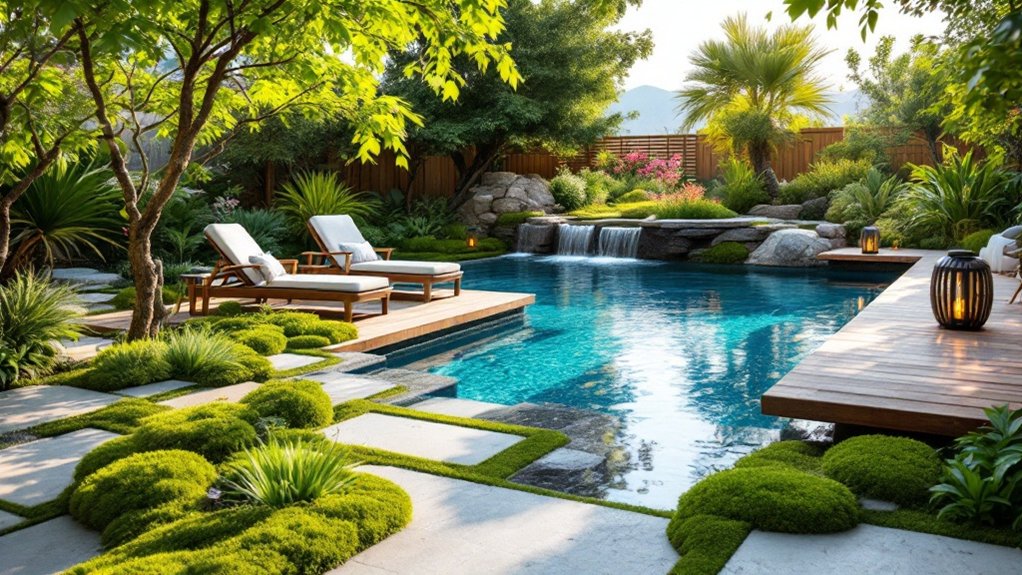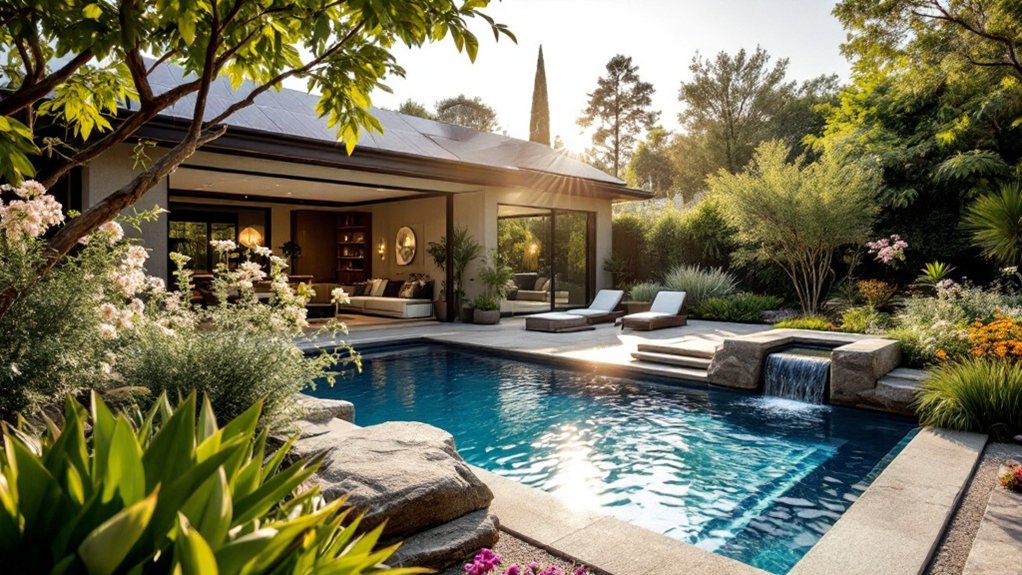Sustainable pool surroundings offer a unique opportunity to merge aesthetics with environmental responsibility. By selecting eco-friendly materials and implementing water-saving technologies, pool owners can transform their spaces. This approach not only enhances the landscape but also promotes local biodiversity. As the trend towards sustainability grows, understanding these practices becomes essential. What specific methods can one employ to create a truly eco-conscious pool environment? The answers may surprise you.
Choosing Eco-Friendly Pool Materials
When selecting materials for a sustainable pool environment, it is crucial to contemplate their environmental impact. Eco-friendly pool materials can greatly reduce the ecological footprint of pool construction and maintenance. Recycled materials, such as glass tiles or reclaimed wood, offer aesthetic appeal while minimizing waste. In addition, natural stone and permeable pavers are excellent alternatives, allowing for better water drainage and reducing runoff. Additionally, using sustainable options for pool decking, such as composite materials made from recycled plastics and wood fibers, enhances durability and lowers maintenance needs. Finally, choosing non-toxic, low-VOC finishes and sealants promotes a healthier environment for both swimmers and surrounding wildlife. Thoughtful selection of these materials fosters a harmonious relationship between pool enjoyment and environmental stewardship.
Implementing Water-Saving Technologies
Implementing water-saving technologies into pool design and maintenance enhances sustainability and conserves valuable resources. Automated pool covers, for instance, greatly reduce evaporation, preserving water and maintaining temperature. Additionally, installing efficient filtration systems minimizes water loss during cleaning processes. Rainwater harvesting systems can collect and utilize natural precipitation for pool refilling, further decreasing dependency on municipal water supplies. Advanced water management systems equipped with sensors can monitor water levels and quality, ensuring ideal usage and timely interventions. By integrating variable-speed pumps, energy consumption is also reduced, aligning with eco-friendly practices. Furthermore, regular equipment inspections can help identify potential issues early, ensuring optimal performance and longevity of the systems. Together, these technologies not only contribute to water conservation but also promote an overall sustainable approach to pool ownership, fostering a healthier environment.
Designing Sustainable Landscaping
In designing sustainable landscaping, a focus on native plant selection can enhance biodiversity while minimizing water usage. Incorporating water-efficient irrigation systems further supports this goal, ensuring that water resources are used judiciously. Additionally, choosing eco-friendly hardscaping materials contributes to an environmentally responsible landscape that complements pool surroundings.
Native Plant Selection
Selecting native plants for landscaping around a pool not only enhances aesthetic appeal but also promotes ecological sustainability. Native plants are adapted to the local climate, requiring less water and maintenance compared to non-native species. They provide habitat for local wildlife, supporting biodiversity and creating a balanced ecosystem. When choosing native plants, it is essential to take into account factors such as soil type, light conditions, and the specific regional climate. Incorporating a variety of native species can create visual interest while ensuring resilience against local pests and diseases. Additionally, native plants can reduce the need for chemical fertilizers and pesticides, further contributing to a healthier environment. Overall, native plant selection is a crucial element in designing sustainable landscaping around pools.
Water-Efficient Irrigation Systems
A well-designed water-efficient irrigation system is essential for sustainable landscaping, especially in pool surroundings. These systems minimize water waste while ensuring that plants receive adequate hydration. Techniques such as drip irrigation deliver water directly to the roots, reducing evaporation and runoff. Timers and moisture sensors can also optimize watering schedules based on real-time weather conditions, further enhancing efficiency. Additionally, utilizing rainwater harvesting systems can supplement irrigation needs, making use of naturally occurring precipitation. By incorporating these strategies, homeowners can create lush, vibrant landscapes around their pools without depleting local water resources. Ultimately, implementing water-efficient irrigation not only supports environmental sustainability but also contributes to the aesthetic appeal of outdoor spaces adjacent to swimming pools.
Eco-Friendly Hardscaping Materials
While designing sustainable landscaping around pools, choosing eco-friendly hardscaping materials plays an essential role in enhancing both functionality and aesthetics. Materials such as permeable pavers allow for natural water drainage, reducing runoff and promoting groundwater recharge. Recycled concrete and reclaimed wood offer durable options that minimize environmental impact while providing unique visual appeal. Additionally, natural stone can be sourced sustainably, ensuring that it contributes to eco-friendly practices. Incorporating these materials not only supports environmental conservation but also creates visually cohesive outdoor spaces. Furthermore, utilizing non-toxic sealants and finishes can further enhance the sustainability of hardscaping projects. Ultimately, selecting eco-friendly hardscaping materials fosters a harmonious balance between nature and design, creating attractive, sustainable pool surroundings.
Utilizing Energy-Efficient Pool Equipment
To create a truly sustainable pool experience, utilizing energy-efficient pool equipment is essential. This includes variable-speed pool pumps, which can considerably reduce energy consumption compared to traditional single-speed models. In addition, energy-efficient heaters and solar pool covers help maintain ideal water temperatures while minimizing electricity use. LED lighting is another effective upgrade, offering lower energy consumption and longer lifespans than conventional bulbs. Moreover, automated control systems can enhance equipment operation, ensuring that systems run only when necessary, thereby saving energy. By investing in these technologies, pool owners can not only reduce their environmental impact but also lower operational costs over time. Ultimately, integrating energy-efficient equipment fosters a more sustainable and enjoyable swimming environment. Regular maintenance of heater fan motors is crucial to ensure they operate efficiently and support these energy-saving efforts.
Reducing Chemical Usage in Pools
Reducing chemical usage in pools is essential for promoting both environmental health and swimmer safety. Traditional pool maintenance often relies heavily on chlorine and other harsh chemicals, which can have detrimental effects on aquatic ecosystems and human health. To minimize chemical input, pool owners can explore alternatives such as saltwater systems, which convert salt into chlorine naturally, or utilize advanced filtration technologies that reduce the need for additional chemicals. Implementing regular maintenance routines, such as frequent cleaning and monitoring water balance, can also help maintain water quality without excessive chemical reliance. In addition, natural enzymes and mineral-based treatments can effectively break down contaminants, providing a safer swimming environment. By adopting these strategies, pool owners contribute to a more sustainable and eco-friendly swimming experience.
Encouraging Local Biodiversity
Creating a sustainable pool environment goes beyond minimizing chemical usage; it also involves fostering local biodiversity. Enhancing the surrounding ecosystem can be achieved by incorporating native plants, which provide habitats for wildlife and attract beneficial insects. These plants require less water and maintenance, promoting sustainability. Additionally, creating a natural buffer zone around the pool with grasses and shrubs helps filter runoff, reducing pollution and protecting aquatic life. Wildlife-friendly features, such as birdhouses and pollinator gardens, support local fauna. By embracing these elements, pool owners can create a vibrant environment that encourages a diverse array of species, ultimately contributing to a healthier ecosystem. This approach not only enhances aesthetic appeal but also supports environmental resilience in the community.
Maintaining Your Sustainable Pool Environment
While establishing a sustainable pool environment is crucial, maintaining it requires consistent effort and attention to detail. Regular cleaning of the pool area minimizes debris accumulation, which can harm local wildlife and plants. Using natural cleaning products further reduces chemical impact on the ecosystem. Additionally, monitoring water quality through eco-friendly testing methods guarantees a safe swimming experience without compromising environmental integrity. It is essential to manage surrounding landscaping by selecting native plants that require minimal irrigation and maintenance. Implementing a rainwater collection system can provide sustainable water for pool upkeep and landscaping. Finally, educating family members on sustainable practices fosters a shared commitment to preserving the environment, guaranteeing the pool remains a harmonious part of the ecosystem. Regular exhaust fan cleaning ensures optimal performance and air quality, contributing to a healthier pool environment.
Frequently Asked Questions
How Can I Finance a Sustainable Pool Project?
To finance a sustainable pool project, one might consider personal loans, green financing options, or local grants. Additionally, exploring partnerships with eco-friendly suppliers can provide valuable discounts while promoting sustainable practices in the community.
What Are the Best Plants for Poolside Sustainability?
The best plants for poolside sustainability include native species, drought-resistant varieties, and those that naturally repel insects. Incorporating such flora enhances biodiversity, minimizes maintenance, and promotes a healthier ecosystem around the pool environment.
Are There Any Certifications for Sustainable Pools?
There are several certifications for sustainable pools, including the Green Pools certification and the Certified Pool and Spa Operator program. These certifications focus on environmentally friendly practices, energy efficiency, and responsible water management in pool construction and maintenance.
How Often Should I Maintain My Sustainable Pool?
The frequency of maintenance for a sustainable pool typically depends on factors like usage and climate. Generally, regular checks should occur weekly, while deeper cleaning and equipment inspections might be necessary monthly or seasonally.
Can I Install a Sustainable Pool Myself?
Installing a sustainable pool oneself is possible, but it requires extensive knowledge of construction, plumbing, and electrical systems. Individuals should consider local regulations, necessary permits, and potential challenges before undertaking such a significant project independently.
Conclusion
In summary, creating sustainable pool surroundings is a multifaceted approach that combines eco-friendly materials, water-saving technologies, and energy-efficient equipment. By embracing native landscaping and reducing chemical usage, pool owners can foster a vibrant ecosystem that promotes local biodiversity. Educating the community on these sustainable practices further enhances the resilience and health of outdoor spaces. Ultimately, the integration of these elements not only beautifies the area but also guarantees a harmonious relationship between leisure and the environment.




